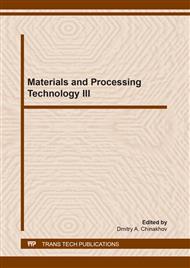[1]
Abdul Khaliq. Metal Extraction Processes for Electronic Waste and Existing Industrial Routes: A Review and Australian Perspective, Abdul Khaliq, Muhammad Akbar Rhamdhani, Geoffrey Brooks and Syed Masood, Resources 2014, 3, 152-179,.
DOI: 10.3390/resources3010152
Google Scholar
[2]
Ogunniyi, I.O., Vermaak, M.K.G., Groot, D.R. Chemical composition and liberation characterization of printed circuit board comminution fines for beneficiation investigations. Waste Manag. 2009, 29, 2140–2146.
DOI: 10.1016/j.wasman.2009.03.004
Google Scholar
[3]
Luda, M.P. Recycling of printed circuit boards. Integr. Waste Manag. 2010, 2, 285–299.
Google Scholar
[4]
Hagelüken, C. Improving Metal Returns and Eco-Efficiency in Electronics Recycling -A Holistic Approach for Interface Optimization between Pre-Processing and Integrated Metals Smelting and Refining. In Proceedings of the IEEE International Symposium on Electronics and the Environment, Scottsdale, AZ, USA, 8–11 May (2006).
DOI: 10.1109/isee.2006.1650064
Google Scholar
[5]
Office of Solid Waste. Electronic Waste Management in the United States–Approach 1; U.S Environmental Protection Agency: Washington, DC, USA, 2008; p.56.
Google Scholar
[6]
Cui, J.; Forssberg, E. Mechanical recycling of waste electric and electronic equipment: A review. J. Hazard. Mater. 2003, 99, 243–263.
DOI: 10.1016/s0304-3894(03)00061-x
Google Scholar
[7]
Institute of Scrap Recycling Industries (ISRI). Scrap Recycling: Where Tomorrow Begins; ISRI: Washington, DC, USA, 2003; p.16–24.
Google Scholar
[8]
Rankin, J. Minerals, Metals and Sustainability–Meeting Future Materials Needs; Commonwealth Scientific and Industrial Research Organization (CSIRO): Melbourne, Australia, (2011).
Google Scholar
[9]
Telyakov A.N., Sizyakov V.M. Theory and practice of precious metals extraction in the complex processing of electronic scrap using oxidative smelting of copper melt // National Mineral Resources University Gorny,, St. Petersburg, 2013. 190 p. (in Russ.).
Google Scholar
[10]
V. Yu. Bazhin, N. M. Telyakov, T. A. Aleksandrova, D. V. Gorlenkov (2019). Production Of Silver Ruble And Participation of the Saint-Petersburg Mining University in the Development of Monetary Industry Of Russia. Journal of mining Institute,, Vol. 236(2), 201. doi:http://dx.doi.org/10.31897/pmi.2019.2.201.
DOI: 10.31897/pmi.2019.2.201
Google Scholar
[11]
Bazhin V. Yu., Aleksandrova T. A., Kotova E. L., Gorlenkov D. V., Susorov R. S. Metallurgists of the mining university and development of coinage. 245 years of history // Publ. St. Petersburg mining university (St. Petersburg), Journal of mining Institute,, Vol. 230, 2018, pp.131-138,.
DOI: 10.17580/cisisr.2020.01.02
Google Scholar
[12]
Guo, J.; Xu, Z. Recycling of non-metallic fractions from waste printed circuit boards: A review. J. Hazard. Mater. 2009, 168, 567–590.
DOI: 10.1016/j.jhazmat.2009.02.104
Google Scholar
[13]
Beloglazov I.I., Petrov P.A., Gorlenkov D.V. Development of an Algorithm for Control Metallurgical Processes of Fluidized Roasting Using an Adaptive Controller. Vol. 1059, IX International Scientific Practical Conference Innovative Technologies in Engineering, 24-26 May 2018, Yurga, Russian Federation. Publishing IOP Conf. Series: Journal of Physics: Conf. Series 1059 (2018).
DOI: 10.1088/1742-6596/1059/1/012015
Google Scholar
[14]
Gorlenkov, D. V., Gorlenkova, I. V., Beloglazov, I. I., & Timofeev, V. Y. (2018). Selection of Complete Recovery of Precious Metals in the Processing of Copper-Nickel Alloys in Hydrometallurgical Way. Materials Science Forum, 927, 190–194. https://doi.org/10.4028/www.scientific.net/msf.927.19.
DOI: 10.4028/www.scientific.net/msf.927.190
Google Scholar
[15]
Gorlenkov D.V. Development of a method for cleaning electrolytes from impurities. Ivanova E.A., Skovorodnikov S.V., Gorlenkova I.V., Gorlenkov D.V. // Collection of scientific papers on the materials of the XVI international scientific-practical conference April 12, 2018. 44 pp. DOI: 10.18411 / spc-12-04-2018-18.
Google Scholar
[16]
Darin A.A., Telyakov N.M., Processing of ferromanganese concretions with the use of sulfatising roasting/Journal of Engineering and Applied Sciences, № 12, V 5, 2017. pp.1113-1115.
Google Scholar
[17]
Koshkina, V.S., Serova, A.A., & Timofeev, V. Y. Environmental-Toxicological Characteristics of Waters and Their Sources at Magnitogorsk With the Its Iron and Steel Industry. // In IOP Conference Series: Materials Science and Engineering (Vol. 142, No. 1, p.012117). IOP Publishing. https://doi.org/10.1088/1757-899X/142/1/012117.
DOI: 10.1088/1757-899x/142/1/012117
Google Scholar
[18]
Aleksandrova, T.A., Telyakov, N.M., Telyakov, A.N. et al. Metallurgist (2017) 61: 188. https://doi.org/10.1007/s11015-017-0475-z.
Google Scholar
[19]
Gorlenkov D.V. The effect of silicon on the electrolytic dissolution of anodes obtained from electronic scrap. D.V. Gorlenkov, A.N. Telyakov, A.I. Zakirova // Non-ferrous metals, No. 3. 2016 pp.31-34. (in Russ.).
DOI: 10.17580/tsm.2016.03.05
Google Scholar
[20]
Alexandrova T.A., Gorlenkov D.V., Romanova N.A. Researching of influence of tungsten, silicon, and impurities oxidation on electrolytic dissolution of Cu-Zn and Fe-Ni-Co anodes / // Periódico Tchê Química (Southern Brazilian journal of chemistry) Vol. 14, N. 28, pp.9-17, 2017, ISSN 2179-0302.
DOI: 10.52571/ptq.v14.n28.2017.9_periodico28_pgs_9_17.pdf
Google Scholar


